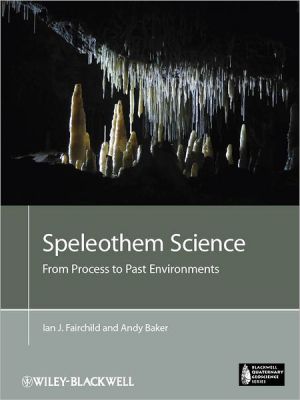

 |

|

Sold Out
Book Categories |
Preface
I: Scientific and Geological Context
1. Introduction to Speleothems and Systems
1.1 What is all the fuss about?
1.2 How is this book organized?
1.3 Concepts and approaches of system science
1.4 The speleothem factory within the karst system
2. Carbonate and Karst Geology
2.1 Carbonates in the Earth system over geological time
2.2 Lithologies of carbonate aquifers
2.3 Carbonate diagenesis and eogenetic karst
2.4 Speleogenesis in mesogenetic and telogenetic karst (with contributions from David J. Lowe and John Gunn)
2.5 Cave infilling
2.6 Conclusion
3. Surface Environments: Climate, Soil and Vegetation
3.1 The modern climate system
3.2 Water isotopes in the atmosphere
3.3 Soils of karst regions
3.4 Vegetation of karst regions
3.5 Synthesis: inputs to the incubator
II: Transfer Processes in Karst
4. The Speleothem Incubator
4.1 Introduction to speleophysiology
4.2 Physical parameters and fluid behaviour
4.3 Water movement
4.4 Air circulation
4.5 Heat flux (authored by David Domínguez-Villar)
4.6 Synthesis: cave climatologies
5. Inorganic Water Chemistry
5.1 Sampling protocols for water chemistry
5.2 The carbonate system
5.3 Weathering, trace elements and isotopes
5.4 Carbon isotopes
5.5 Evolution of water chemistry: modelling sources and environmental signals
6. Biogeochemistry of Karstic Environments
6.1 Introduction
6.2 Organic macromolecules
6.3 Pollen and Spores
6.4 Cave faunal remains
6.5 Synthesis and research gaps
III: Speleothem Properties
7. The Architecture of Speleothems
7.1 Introduction
7.2 Theoretical models of stalagmite growth and of stalagmite and stalactite shapes
7.3 Geometrical classification of speleothems
7.4 Mineralogy and petrography
7.5 Synthesis
8. Geochemistry of Speleothems
8.1 Analysis and the sources of uncertainty
8.2 The growth interface
8.3 Trace element partitioning
8.4 Oxygen and carbon isotope fractionation
8.5 Evolution of dripwater and speleothem chemistry along water flowlines
8.6 Process models of variability over time
9. Dating of Speleothems
9.1 Introduction
9.2 Dating techniques
9.3 Age-distance models
9.4 Conclusions
IV: Palaeoenvironments
10. The Instrumental Era: Calibration and Validation of Proxy-Environment Relationships
10.1 Available instrumental and derived series
10.2 Methodologies
10.3 Case studies of calibrated speleothem proxies
10.4 Questions raised and future directions
11. The Holocene Epoch: Testing the Climate and Environment Proxies
11.1 A brief overview of the Holocene
11.2 The last millennium
11.3 Holocene environmental changes- speleothem responses
11.4 Questions raised and future directions
12. The Pleistocene and Beyond
12.1 Pleistocene proxy records ( ice-age climate fluctuations defined and drawn)
12.2 Insights into pre-Quaternary environments
12.3 Questions raised and forward look
Appendix 1. Archiving Speleothems and Speleothem Data
Index
Login|Complaints|Blog|Games|Digital Media|Souls|Obituary|Contact Us|FAQ
CAN'T FIND WHAT YOU'RE LOOKING FOR? CLICK HERE!!! X
 You must be logged in to add to WishlistX
 This item is in your Wish ListX
 This item is in your CollectionSpeleothem Science: From Process to Past Environments
X
 This Item is in Your InventorySpeleothem Science: From Process to Past Environments
X
 You must be logged in to review the productsX
 X
 X

Add Speleothem Science: From Process to Past Environments, Speleothems (mineral deposits that formed in caves) are currently giving us some of the most exciting insights into environments and climates during the Pleistocene ice ages and the subsequent Holocene rise of civilizations. The book applies system scienc, Speleothem Science: From Process to Past Environments to the inventory that you are selling on WonderClubX
 X

Add Speleothem Science: From Process to Past Environments, Speleothems (mineral deposits that formed in caves) are currently giving us some of the most exciting insights into environments and climates during the Pleistocene ice ages and the subsequent Holocene rise of civilizations. The book applies system scienc, Speleothem Science: From Process to Past Environments to your collection on WonderClub |